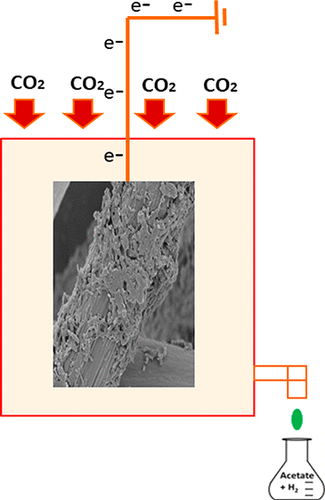当前位置:
X-MOL 学术
›
ACS Sustain. Chem. Eng.
›
论文详情
Our official English website, www.x-mol.net, welcomes your
feedback! (Note: you will need to create a separate account there.)
Effect of Electroactive Biofilm Formation on Acetic Acid Production in Anaerobic Sludge Driven Microbial Electrosynthesis
ACS Sustainable Chemistry & Engineering ( IF 7.1 ) Pub Date : 2019-12-20 , DOI: 10.1021/acssuschemeng.9b05420 Fuad Ameen 1 , Wafa A. Alshehri 2 , Saleh Al Nadhari 3
ACS Sustainable Chemistry & Engineering ( IF 7.1 ) Pub Date : 2019-12-20 , DOI: 10.1021/acssuschemeng.9b05420 Fuad Ameen 1 , Wafa A. Alshehri 2 , Saleh Al Nadhari 3
Affiliation

|
Microbial electrosynthesis (MES) is a biocathode driven production of value added platform chemicals from carbon dioxide (CO2), which is regarded as a sustainable carbon mitigation approach. In this technique, electrons are supplied from external sources and subsequently utilized by the microorganisms present in the MES cathode for converting CO2 into useful chemicals (i.e. acetic acids, butyric acid, propanol, ethanol, etc.). However, the performance of MES severely depends on the formation of an electroactive biofilm with the ability of paramount charge discharging properties. In the present work, we have investigated the influence of electroactive biofilm formation on the performance of acetic acid production in an anaerobic sludge driven MES system. The formation electroactive biofilm on the MES biocathode was characterized using different electrochemical techniques, such as chronoamperometry, linear sweep voltammetry, cyclic voltammetry, and electrochemical impedance spectroscopy, and correlated with the performance of acetic acid production. The electrochemical results demonstrated that the formation of mature electroactive biofilms on biocathodes enabled a maximum 36.66 mmol/L of acetic acids. Furthermore, the influence of different applied potentials on electroactive biofilm formation as well as acetic acid production was investigated, and it was observed that the applied potential of −0.68 V achieved maximum reducing current and acetic acid production together with maximum CO2 consumption. The phylogenetic analysis of cathode biofilm revealed that Burkholderiales sp., Sulfurospirillum sp., Acetoanaerobium sp., and Lysinibacillus sp. were the predominant microbial genera associated with the electrosynthetic reactions in MES systems. The results of the present study suggest that the formation of an electroactive biofilm enriched with electrosynthetic genera is beneficial to avail maximum performance in MES systems.
中文翻译:

电活性生物膜形成对厌氧污泥驱动微生物电合成乙酸生产的影响
微生物电合成(MES)是由生物阴极驱动的二氧化碳(CO 2)增值平台化学品的生产,这被认为是可持续的碳减排方法。在该技术中,将电子从外部源提供并随后由存在于MES阴极微生物用于将CO利用2成有用的化学品(即,乙酸,丁酸,正丙醇,乙醇,等)。然而,MES的性能严重取决于具有最重要的电荷放电性能的电活性生物膜的形成。在目前的工作中,我们已经研究了厌氧污泥驱动的MES系统中电活性生物膜形成对乙酸生产性能的影响。MES生物阴极上形成的电活性生物膜的表征采用了不同的电化学技术,例如计时电流法,线性扫描伏安法,循环伏安法和电化学阻抗谱,并与乙酸的生产性能相关。电化学结果表明,在生物阴极上形成成熟的电活性生物膜可实现最大36.66 mmol / L的乙酸。此外,2消费。阴极生物膜的系统发育分析表明Burkholderiales sp。,Sulfurospirillum sp.。,醋杆菌属。和Lysinibacillus sp。是与MES系统中的电合成反应相关的主要微生物属。本研究的结果表明,形成富含电合成属的电活性生物膜有利于在MES系统中发挥最大性能。
更新日期:2019-12-21
中文翻译:

电活性生物膜形成对厌氧污泥驱动微生物电合成乙酸生产的影响
微生物电合成(MES)是由生物阴极驱动的二氧化碳(CO 2)增值平台化学品的生产,这被认为是可持续的碳减排方法。在该技术中,将电子从外部源提供并随后由存在于MES阴极微生物用于将CO利用2成有用的化学品(即,乙酸,丁酸,正丙醇,乙醇,等)。然而,MES的性能严重取决于具有最重要的电荷放电性能的电活性生物膜的形成。在目前的工作中,我们已经研究了厌氧污泥驱动的MES系统中电活性生物膜形成对乙酸生产性能的影响。MES生物阴极上形成的电活性生物膜的表征采用了不同的电化学技术,例如计时电流法,线性扫描伏安法,循环伏安法和电化学阻抗谱,并与乙酸的生产性能相关。电化学结果表明,在生物阴极上形成成熟的电活性生物膜可实现最大36.66 mmol / L的乙酸。此外,2消费。阴极生物膜的系统发育分析表明Burkholderiales sp。,Sulfurospirillum sp.。,醋杆菌属。和Lysinibacillus sp。是与MES系统中的电合成反应相关的主要微生物属。本研究的结果表明,形成富含电合成属的电活性生物膜有利于在MES系统中发挥最大性能。











































 京公网安备 11010802027423号
京公网安备 11010802027423号